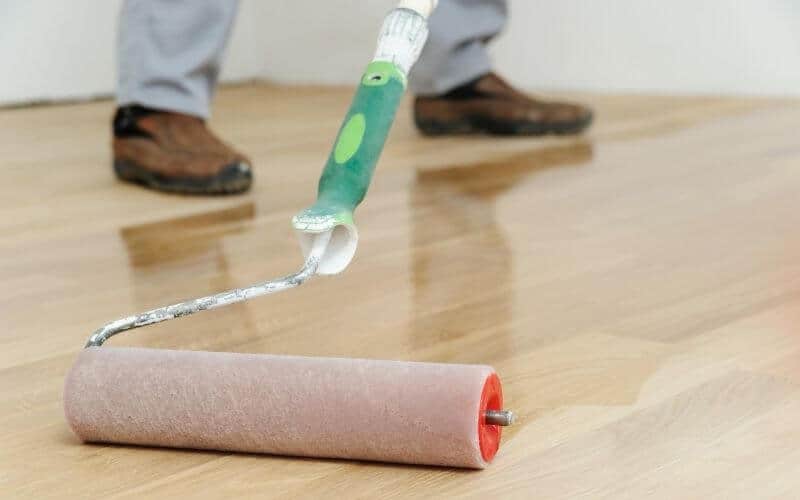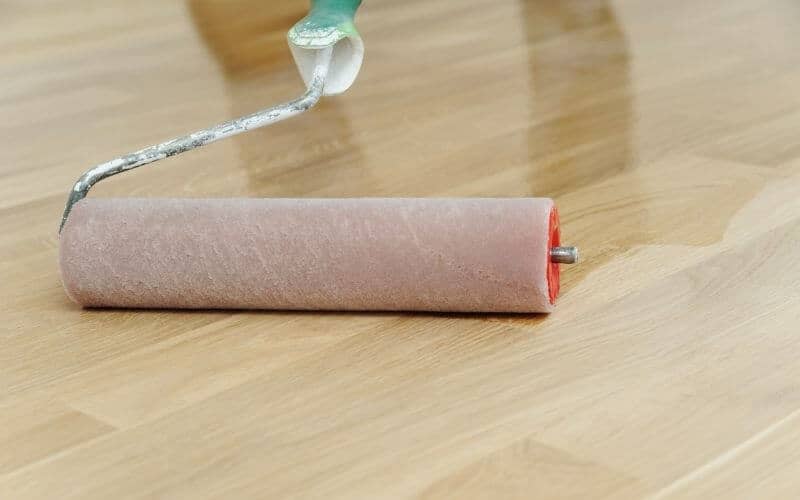Hardwood flooring gets scratched and dull as it ages, but unlike other types of flooring, the beauty of hardwood flooring can be restored by refinishing.
Hardwood flooring can be refinished up to 10 times during its lifetime. Yes, you’ll save money when you carry out the refinishing yourself, but you need to know what to expect when refinishing hardwood floors as it isn’t exactly a walk in the park, and mistakes show up big time.
Here are a few caveats to consider before taking on a refinishing job on a hardwood floor.
Read: How to refinish distressed hardwood floor
What to Expect when Refinishing Hardwood Floors
Table of Contents
- 1 What to Expect when Refinishing Hardwood Floors
- 1.1 1. Handling the Sander
- 1.2 2. How Long the Process Takes
- 1.3 3. Needed Preparations to Make
- 1.4 4. Cost of Job
- 1.5 5. Get the Product Information
- 1.6 6. Determine the Woods Thickness
- 1.7 7. Number Of Coats Needed
- 1.8 8. Potential Delays
- 1.9 9. Keep Pets Away
- 1.10 10. How Long do you Keep Off the Floors
- 1.11 11. How Much Clean-Up Will be Needed?
- 1.12 12. Follow Up Maintenance Required
- 1.13 13. Choose your Floor Stains
- 1.14 14. Choose the Type Of Finish
- 2 How to Refinish your Hardwood Floor Without Sanding
- 3 Conclusion
1. Handling the Sander
One of the top challenges you may experience as you sand your hardwood floor as a DIYer is handling a drum sander; this piece of equipment is heavy and needs to be properly handled if you want to achieve a great result. Remaining in one spot for too long will carve a divot in your floor that’s probably unfixable.
2. How Long the Process Takes
Exactly how long a refinishing job will take you depends on the type of polyurethane you make use of, either water-based or oil-based; hardwood floors that are finished with an oil-based sealant usually take a bit longer to dry.
3. Needed Preparations to Make
Refinishing hardwood floors requires minimal preparation even if you have intricate mosaic floor patterns; all you need to do is clear out the room.
If you hire the services of professionals, most companies are fully qualified and trained to complete any prep work involved with the job.
You may also need to lightly clean the floor before you begin refinishing and also make plans to avoid the areas being refinished during that period.
If there’s furniture in the room, you can move it to another area of the home. You can carry out the work in two separate installments if there’s nowhere to move your furniture and accommodate foot traffic needs.
Read: How to move furniture without scratching floor
4. Cost of Job
The cost of a refinishing job varies depending on the contractor’s expertise, the products used, and the amount of work to be done.
Make proper research on what you need and the product to be used. You can also get quotes from a couple of contractors that use those products.
5. Get the Product Information
Being educated on the products to be used on your floor is very important so ask your contractor for a portfolio of information, brochures or specification sheets on the products to be used on your floor.
If you are doing the refinishing yourself, read the products label and instructional manual before using, and you can also contact the company if you have any questions. This is especially important if someone your the home has any chemical sensitivities.
6. Determine the Woods Thickness
Determine the thickness of the wood before refinishing, your contractor can assess it for you, or you can do that yourself by looking at certain areas to determine the wear layer.
This you can measure by looking through vents or the transitional points of the wood to other floorings in the home.
7. Number Of Coats Needed
The standard number of coats needed to be applied on a hardwood floor after sanding is three. One coat of a sealant which could also act as the stain, and two coats of finish. You can apply additional coats of finish if needed.
8. Potential Delays
Before you begin refinishing your hardwood floor, you need to be able to determine what products are currently on your floors; inability to do so can cause unnecessary delays, which lengthens the sanding process.
This is why it is important to be educated on any product used on your floors. Temperature and relative humidity can also affect how long the product dries for.
9. Keep Pets Away
If you have pets, it is a good idea to keep them off the floors during the sanding and finishing process until the finish is fully cured, even if the product is marketed to be pet friendly. This is to avoid contamination and tracking of dirt or hair into the polyurethane coating.
10. How Long do you Keep Off the Floors
Until it is fully cured, your floor finish will be highly susceptible to scuffing and scratching. So it needs to be left to dry for at least 4 hours before being walked on with stocking feet, but furniture cannot be placed back on the floor until 48 hours.
The finish needs to have been fully cured for at least a week before area rugs can be put down.
Read: How long does polyurethane take to cure
11. How Much Clean-Up Will be Needed?
How much cleanup needs to be done after a refinishing job depends largely on who did the job. Some professionals are better at caring about your indoor air quality and have invested in dust extraction systems.
Some contractors use a makeshift dust extractor, which is a bag attached to their sanding equipment; this isn’t a very effective way to keep airborne dust out of your house.
Although dust extraction systems are not 100% effective, they can remove a large amount of dust, and you aren’t left with much cleanup to do.
If you think this is an unnecessary cost, then you probably don’t mind living in a dust storm until the finishers leave. This dust can find its way and settle anywhere; kitchen cabinets, vents, and literally every crevice of your home.
This you can avoid by spending hours taping off rooms, covering drapes, and request cleaning services after the refinishing is done. Poor dust control can also affect the final appearance of the floor and even everyday health.
If you are using a product like the bona systems, it requires minimal cleanup as the sanding is dust-free, and every airborne dust generated during the sanding process is eliminated; this reduces the time needed in hanging and taking down plastic sheets and tapes used to cover areas in the home.
If you hire a contractor, everything is picked up and cleaned before the finishing touches are made; this way, you are not left with any mess in your home.
Read: Should you dust or vacuum first?
12. Follow Up Maintenance Required
This depends on the amount of traffic the floor receives, and if you have children and pets, if you do or if the floor receives a lot of traffic, you will need to clean more regularly.
Dusting your floors with a dust mop daily or every other day is also recommended. You need to clean your hardwood floor regularly with a waterborne, non-toxic formula that is safe to be used on hardwood floors.
13. Choose your Floor Stains
After refinishing your wood floors, you can decide to stain it with a new color like rich mahogany, or dark oak, which are the most sought-after colors right now.
14. Choose the Type Of Finish
You can opt for a glossy or satin finish, and they both look lovely, although stain finishes are beginning to gain popularity, especially in households with kids. This is because it’s less easy to slip on a satin finish than their shiny counterparts.
There are also a few more floor finishing facts you may want to know:
- Waxed floors are very slippery and also not as durable as a urethane-based coating.
- Water-based polyurethane finishes are low VOC, which means they aren’t as hazardous or have a strong smell as their oil-based counterparts.
Read: How to finish parquet flooring
How to Refinish your Hardwood Floor Without Sanding
Sometimes you do not need to go all the way and completely refinish your hardwood floor to revamp its look, something as easy as deep cleaning or a simple finish retouch can get your floor looking brand new.
Deep Cleaning
If there aren’t so many scratches or dents on your hardwood and it simply looks dull from the accumulation of dirt, a good deep clean should restore the floor’s luster. Here’s what to do:
- Start by sweeping the floor thoroughly with a soft-bristled brush, do not use stiff bristles that can scratch the wood’s surface.
- Next, use a vacuum to clean hard-to-reach areas removing dirt in room corners and between floorboards.
- Next, with a microfiber cloth and concentrated cleaner suitable for hardwood floors, mop the floor. When cleaning hardwood, do not use steam, water, vinegar, and cleaners like murphy’s oil soap.
If the hardwood floors are in a high-traffic area of your home, you may need to hire an expert to deep clean your flooring.
Aside from deep cleaning your floors, here’s what you need to do to keep your hardwood floor in best shape:
- Clean the floor surface three times per week using a vacuum or micro cloth.
- Deep clean the floor at least once per month using a concentrated wood floor cleaner.
- Professionally deep clean your hardwood floors once per year.
Apply New Finish Without Sanding
If deep cleaning didn’t restore your hardwood floor’s shine, apply a layer of new finish, this could be done without sanding or staining, and your hardwood floor will look good as new
In fact, there are products created to refresh hardwood floors without sanding; they have a thick consistency and can be used to fill light scratches and soften small dings.
When Refinishing Is The Best Option
If your hardwood floor is beyond quick fixes and has lots of deep scratches and wide gaps, it will need refinishing.
Refinishing hardwood floors is a lengthy and labor-intensive process, especially if you are undertaking the job yourself.
Before refinishing your floor, you need to know each step: sanding, patching, staining, and top coating; it may take up to three days or more to complete a refinishing of a floor less than 500 square feet.
If you want your floors professionally refinished, you can hire local contractors, and the cost depends on your area but should be anywhere between $3 or $4 per square foot.
Get bids from three or more companies, which usually involves a free inspection visit to your home.
Read: Can you refinish engineered wood floor?
Conclusion
Now that you know all what to expect when refinishing hardwood floors, you can go ahead and begin refinishing, it may be a tedious and time-consuming process, but the end result is always worth it.

